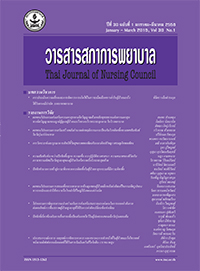ปัจจัยทำนายการเข้าสู่ภาวะช็อกจากการติดเชื้อในผู้ป่วยอายุรกรรม ที่มีภาวะติดเชื้อ
Keywords:
โรคร่วม, ดัชนีแสดงภาวะช็อก, ระดับนำ้ตาลในเลือด, ผู้ป่วยอายุรกรรม, ภาวะช็อกจากการติดเชื้อ, comorbidity, shock index, blood glucose level, medical patient, septic shockAbstract
บทคัดย่อ: วัตถุประสงค์ของการวิจัย: ศึกษาอำนาจการทำนายของ การมีโรคร่วม ดัชนีแสดงภาวะช็อกระดับนำ้ตาลในเลือด ต่อการเข้าสู่ภาวะช็อกจากการติดเชื้อในผู้ป่วยอายุรกรรมที่มีภาวะติดเชื้อ
การออกแบบการวิจัย: การวิจัยเชิงทำนาย
วิธีดำเนินการวิจัย: กลุ่มตัวอย่างเป็นผู้ป่วยภาวะติดเชื้อที่เข้ารับการรักษาในหอผู้ป่วย อายุรกรรมโรงพยาบาลศิริราช จำนวน 90 ราย เครื่องมือวิจัยประกอบด้วย (1) แบบบันทึกข้อมูลพื้นฐานของผู้ป่วย (2) แบบประเมินโรคร่วม (Charlson comorbidity index) (3) แบบบันทึกดัชนีแสดงภาวะช็อก (4) แบบบันทึกระดับนำ้ตาลในเลือด และ (5) แบบบันทึกข้อมูลการเกิดภาวะช็อกจากการติดเชื้อ วิเคราะห์ข้อมูล โดยใช้สถิติเชิงพรรณนาและการวิเคราะห์การถดถอยโลจิสติกแบบเลือกทั้งหมด
ผลการวิจัย: กลุ่มตัวอย่างมีอายุเฉลี่ย 68.61 ปี (S.D.=14.97) เป็นเพศหญิงร้อยละ 51.1 และร้อยละ26.7 พบว่า การมีโรคร่วม ดัชนีแสดงภาวะช็อก และระดับนำ้ตาลในเลือดสามารถร่วมกันทำนายการเกิดภาวะช็อกจากการติดเชื้อของกลุ่มตัวอย่างได้ ร้อยละ 44.7 (Nagelkerke R2 = .447) โดยตัวแปรที่สามารถใช้ทำนายการเกิดภาวะช็อกจากการติดเชื้อ ได้แก่ ระดับนำ้ตาลสูงกว่าระดับควบคุม (OR =.08, 95% CI = .019-.333, p <.01) และดัชนีแสดงภาวะช็อกระดับสูงจนเกิดอันตราย (OR =5.228,95% CI = 1.417-19.285, p<.05)
ข้อเสนอแนะ: พยาบาลควรมีการนำแบบประเมินดัชนีแสดงภาวะช็อกไปใช้และมีการติดตามระดับนำ้ตาลในเลือด ในการเฝ้าระวังและป้องกันการเข้าสู่ภาวะช็อกในผู้ป่วยติดเชื้อ
Abstract: Objective: To examine the power of comorbidity, shock index and blood glucose level to predict a septic shock condition suffered by septicaemic medical patients.
Design: Predictive research.
Implementation: The subjects were 90 septicaemic patients in a medical ward of Siriraj Hospital. The instruments comprised (i) a general patient’s information form; (ii) Charlson comorbidity index; (iii) a shock index recording form; (iv) a blood glucose form; and (v) a septic shock form. The data were analysed using descriptive statistics and total logistic regression analysis.
Results: According to the study, the subjects, 51.1 percent of whom were female, were averagely 68.61 years of age (SD =14.97). More than one-fourth (26.7%) of the subjects displayed symptoms of comorbidity. It was also found that comorbidity, shock index and blood glucose level formed a combined predictive factor for the septic shock in up to 44.7% of the subjects (Nagelkerke R2 = .447). The other variables capable of predicting septic shock were blood glucose level exceeding the regulated level (OR = .08, 95% CI = .019-.333, p < .01) and dangerously high shock index (OR = 5.228, 95% CI = 1.417-19.285, p <. 05).
Recommendations: It is suggested that nurses apply the shock index to their patient-care activities and perform regular blood glucose level follow-ups, as a precaution against and prevention of septic shock in septicaemic patients.








